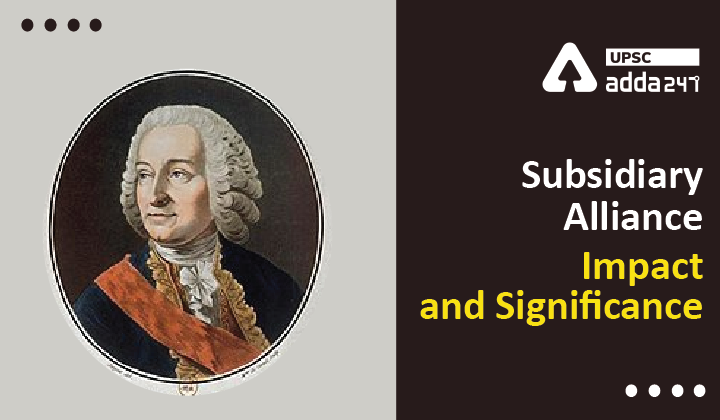Table of Contents
Subsidiary Alliance- Relevance for UPSC Exam
- GS Paper 1: Indian History- Modern Indian history from about the middle of the eighteenth century until the present- significant events, personalities, issues.
What is Subsidiary Alliance System
- The subsidiary Alliance System was basically a treaty between the British East India Company and the Indian rulers.
- Under Subsidiary Alliance System, the Indian Ruler was made subservient to the wishes of the British East India Company (EIC).
- Hence, the Indian kingdoms who signed the Subsidiary Alliance lost their sovereignty to the English.
Background of Subsidiary Alliance System
- A French Invention: Subsidiary Alliance in India is considered to be a French alliance. French Governor Dupleix is credited with the introduction of the Subsidiary Alliance System in India.
- Dupleix was the first who lend European troops to the Indian state in return of some territory and influence over the native state.
- Lord Wellesley and Subsidiary Alliance: Lord Wellesley was an expansionist and wanted to reduce states to a position of dependence on the British Government in India.
- For this purpose, he introduced the system of subsidiary alliance which is considered to be an extension of the Ring Fence Policy.
Subsidiary Alliance System | Background and Key Features
Chronology in which the Indian States Signed Subsidiary Alliance
- Hyderabad (1798)
- Mysore (1799)
- Tanjore (1799)
- Awadh (1801)
- Peshwa (Marathas) (1802)
- Scindia (Marathas) (1803)
- Gaekwad (Marathas) (1803)
Impact of Subsidiary Alliance in India
- Expansion of British Empire: Subsidiary Alliance fueled the expansionary zeal of the British empire as it led to their territorial Expansion without much bloodshed or economic cost.
- British would cede a portion of territory if a ruler failed to make the payment. This was done in the name of maintaining the troops.
- This was the outcome in most cases, as rulers fell into arrears and a part of their territory was taken.
- Rampant Unemployment: As a part of the Subsidiary Alliance, Indian Rulers were supposed to disband their army. This led to widescale unemployment in India.
- Loss of Independence of Indian Rulers: As per the subsidiary alliance, Indian rulers were not allowed to form a federation or sign any treaty with their fellow rulers in India.
- They were also barred from employing other European and a British resident was placed in the capital of the Indian ruler who signed the Subsidiary Alliance.
- These measures completely took away the Independence of the Indian rulers. They became a protectorate of the British East India Company (EIC).
Significance of Subsidiary Alliance for Britishers
- Control over Strategic Positions: Stationing of the British Army and a resident at the capital of Indian rulers gave Britishers effective control over strategic and key locations in India.
- British resident also, kept in check any attempt by the Indian ruler to violate the subsidiary alliance treaty.
- Countering French Influence: The subsidiary Alliance system helped the British EIC to effectively counteract any possible French move in India.
- The subsidiary Alliance system also required the subsidiary ally to dismiss all Frenchmen from his service.
- Speedy Movement of Troops: Stationing of British troops in the capital of subsidiary ally helped them move the Army swiftly across key strategic locations in India. This helped them in effectively and swiftly countering any threats of revolt.
Subsidiary Alliance System | Background and Key Features





 TSPSC Group 1 Question Paper 2024, Downl...
TSPSC Group 1 Question Paper 2024, Downl...
 TSPSC Group 1 Answer key 2024 Out, Downl...
TSPSC Group 1 Answer key 2024 Out, Downl...
 UPSC Prelims 2024 Question Paper, Downlo...
UPSC Prelims 2024 Question Paper, Downlo...





